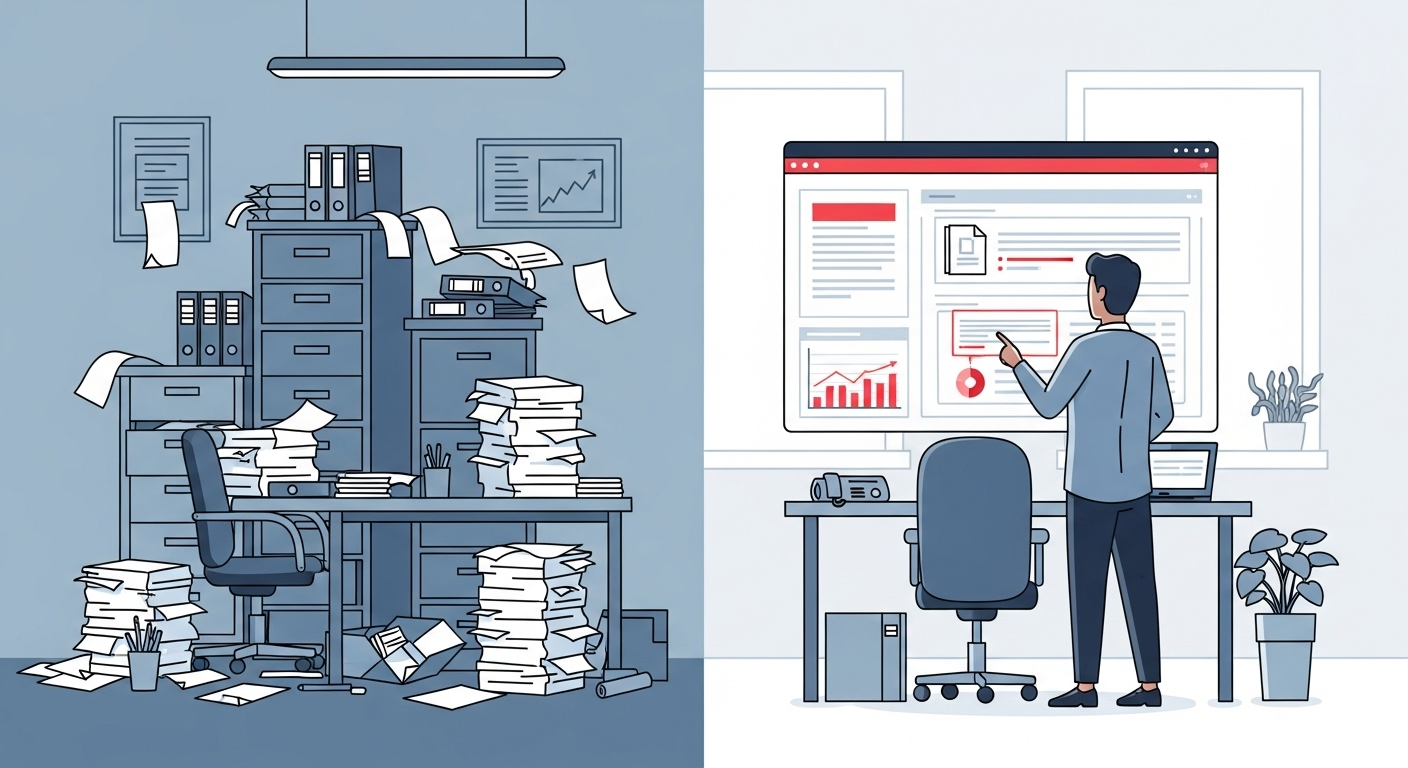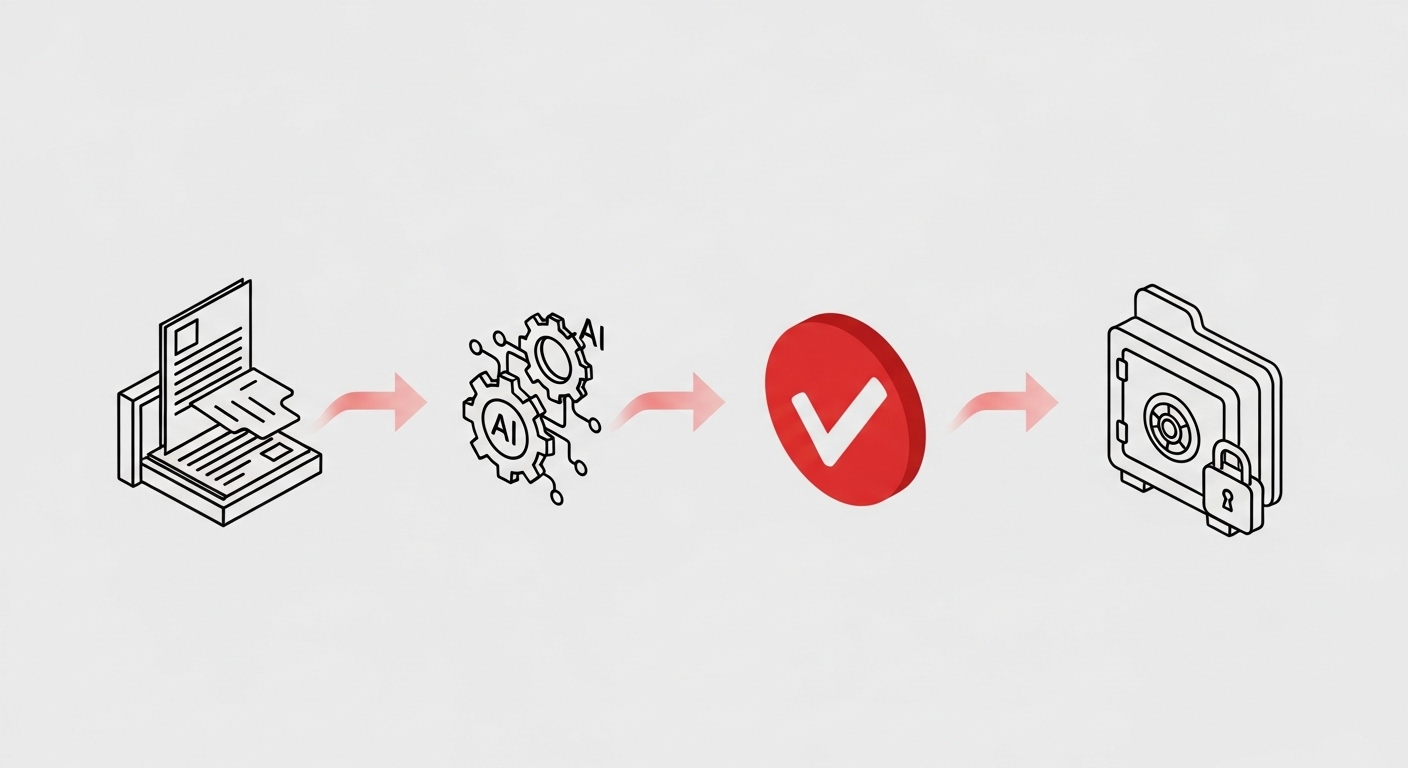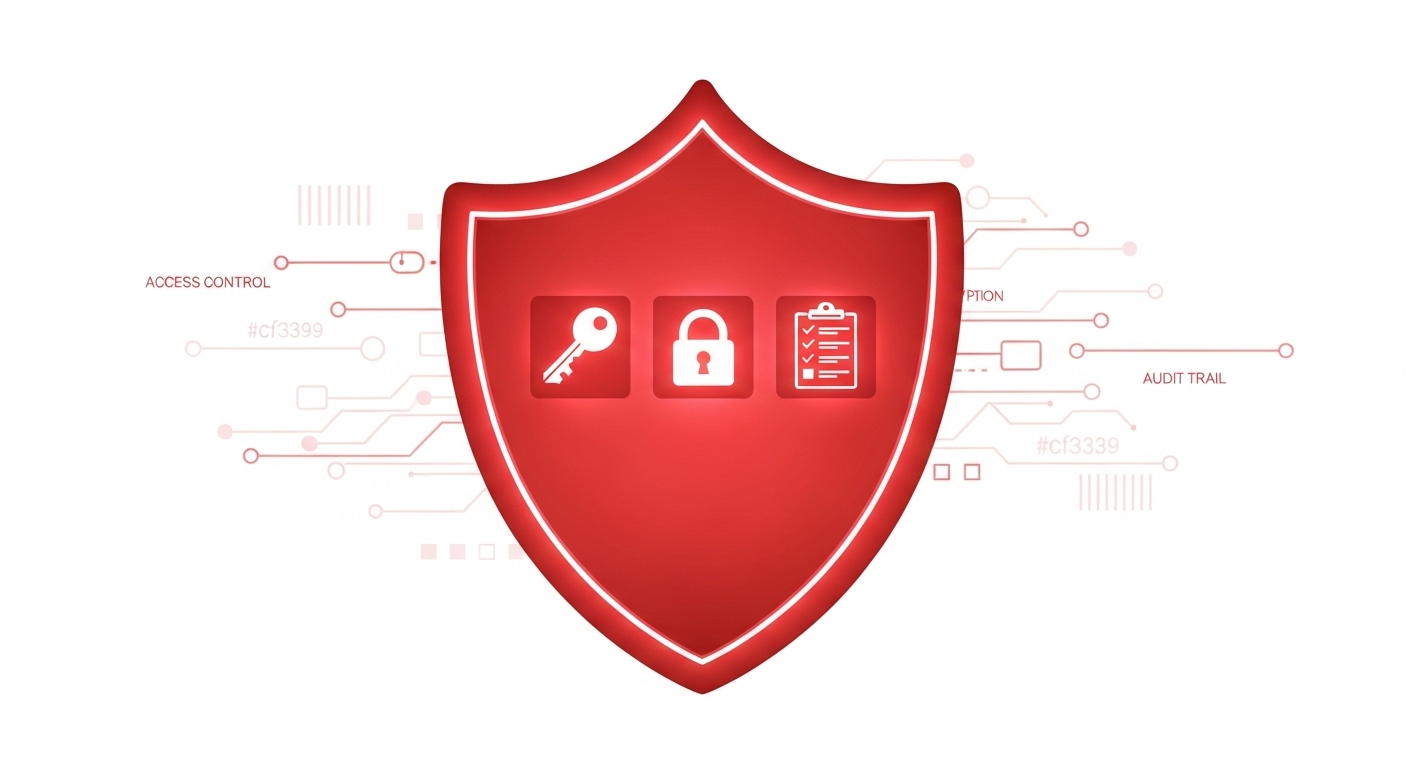
Benefits of Cloud-Based Digital Document Storage (ECM vs. DMS)

The risks of data loss and the hours your team spends searching for files are a direct drain on your business.
Organizations that switch to a digital document storage see real results, with cost reductions up to 30% and nearly 50% faster document processing, according to Mordor Intelligence.
If your business is buried under paperwork, this guide is your roadmap to breathing easier. Learn how a smart digital document storage platform can simplify operations, streamline your operations, and keep your critical business information secure.
Digital document storage is the practice of converting physical documents, such as paper files, paper records, and invoices, into electronic formats, then organizing them within centralized digital repository.
The primary goal is to enhance security and accessibility and streamline operational efficiency.
Unlike traditional paper-based filing or basic cloud folders, this process uses Document Management System (DMS) or Enterprise Content Management (ECM) platform to apply structure, automation, and advanced security to your business-critical information.
Dokmee’s platform is designed to make the transition from paper or basic cloud storage simple and secure.
Relying on traditional document storage methods is inefficient. It actively costs you money and exposes you to unnecessary risk.

This operational friction impacts your bottom line every single day. For example:
Setting up physical storage might seem affordable initially, but its ongoing maintenance and inefficiency costs quickly add up.
A digital system, in contrast, delivers compounding returns over time. The tangible business case for making the transition is clear when you compare them directly.
Note: These numbers are a conservative approximation for a medium-sized business, costs will vary based on your organization’s geography, scale, and complexity.
| Storage Method | Initial Setup | Annual Maintenance | Document Retrieval Time | Security Level |
|---|---|---|---|---|
| Paper-Based Document Management | $2,000–$5,000 | $8,000–$12,000 | 5–15 minutes | Basic |
| Digital Document Storage (DMS or ECM) | $3,000–$8,000 | $2,000–$4,000 | 10–30 seconds | Enterprise-Grade |
| Hybrid Systems | $5,000–$10,000 | $5,000–$8,000 | 1–5 minutes | Enhanced |
Stephen Mackey, an expert in information rights management and digital content systems, explains that document digitalization and digital document storage are no longer a nice-to-haves.
They help businesses cut costs, improve collaboration, strengthen security, and make faster decisions by reducing paper dependency. Many businesses see significant returns on investment a year in.
Industries like healthcare, finance, and legal services face strict document retention and security requirements.
Physical storage and basic cloud tools put your data at risk. Gaps in compliance and security or missing files will slow you down and cost you down the line.
A digital document storage system is inherently more secure.
It’s designed with automated compliance features like time-stamped access logs, role-based access controls, and encryption, and it can be the solution to your organization’s storage, efficiency, cost, and compliance-related issues.
Now that we’ve established the high costs and risks of outdated storage methods, let’s explore how a Document Management System (DMS) directly solves these problems.
A digital document storage is not a digital folder.
It’s an active system designed to make your business processes more efficient, intelligent, and secure. The most immediate benefit is that it creates a centralized repository for all your business documents.
Unlike simple cloud storage services like Google Drive or Microsoft OneDrive, where files often become disorganized, a DMS provides a structured framework designed for professional use.
This means no more searching through scattered email attachments or shared drives, everyone on your team knows exactly where to find the most current version of any file.
Modern DMS platforms use AI-powered indexing and Optical Character Recognition (OCR) to make every document searchable, not just by its filename, but by its content.
OCR technology indexes the text from scanned documents, including handwritten notes.
This is a game-changer for productivity. For example, medical staff can instantly search for patient information using multiple criteria, such as a patient’s name, diagnosis codes, or specific treatment dates, which dramatically reduces administrative time and improves patient care.
A DMS is designed to automate the repetitive, manual tasks that consume your staff’s time.

You can build structured approval workflows that route documents automatically based on predefined rules.
In other words, once a DMS is integrated into an organization’s workflows, staff rarely need to oversee the operations, which eliminates the risks of delays, misplacement, and the use of outdated versions and results in substantial savings of time and resources for everyone involved.
However, while a DMS is a powerful tool for solving such operational problems, some organizations need to manage a wider universe of content.
This is where Enterprise Content Management (ECM) comes in. More than a document management tool, an ECM system is a comprehensive platform for governing the entire lifecycle of all your business content.
Think of the difference between DMS and ECM systems this way way: a DMS is a highly organized, secure digital filing cabinet for your documents, whereas an ECM is the entire information backbone for your organization.
ECM platforms are designed to manage both structured and unstructured content within an integrated environment.
Large organizations often require an ECM solution because a DMS alone cannot effectively manage the diverse content types they handle. In brief:
| Feature | Document Management System (DMS) | Enterprise Content Management (ECM) |
|---|---|---|
| Primary Scope | Manages individual documents and files. | Governs the entire lifecycle of all business content. |
| Content Handled | Primarily structured content like PDFs, Word documents, and spreadsheets. | Both structured and unstructured content, including: Customer emails Product manuals Multimedia files (video, audio) Database records |
| Core Function | To provide a centralized, secure repository for organizing and retrieving documents. | To integrate and manage all information assets across the entire organization. |
| Best For | Organizations looking to solve document-related operational problems efficiently. | Large organizations that need to manage a divers universe of content within an integrated ecosystem. |
ECMs are extremely powerful because you can integrate them with your other core business applications to create a unified information ecosystem. This eliminates the operational friction caused by information silos, where employees have to switch between multiple applications to find what they need.
This means your sales team can access proposal templates, contract histories, and client communications all from a single interface, which eliminates the operational inefficiencies and dramatically improves their efficiency and effectiveness.
ECM platforms accommodate organizational growth without requiring costly infrastructure overhauls.

As your business expands, an ECM system can support hundreds or even thousands of employees while maintaining consistent document management practices.
You don’t need to worry about storage capacity, as it scales automatically.
User permissions can be easily adjusted to reflect changing organizational structures, and integration options can expand as your business adopts new technologies.
This combination of security, accessibility, and control is what makes a modern cloud-based digital document storage so essential. Let’s look at the specific features that make this possible.
Modern DMS and ECM, such as Dokmee, make your documents immensely secure, efficient, and accessible. You no longer need to struggle with file-hunting or manual processes thanks to its features designed for the modern, distributed workforce.

A modern DMS protects your sensitive information with multiple layers of security.
Notably, end-to-end encryption to make sure that your documents remain secure during transmission and storage, and multifactor authentication to prevent unauthorized access and keep private data safe from prying eyes.
Other advanced security features include:
Most organizations require document access from various locations and devices.
A cloud-based DMS enables secure remote access while maintaining your enterprise security standards.
Users authenticate through corporate directories, access documents through encrypted connections, and work within permission boundaries you establish as an administrator.
This capability is especially valuable for organizations with distributed teams, field workers, or client-facing staff who need immediate document access during meetings or site visits.
Unlike physical document storage or basic cloud drives, a DMS facilitates real-time collaboration while preventing version conflicts.
Multiple users can work on documents simultaneously, with all changes tracked and attributed to specific contributors. The version control system maintains a complete history, which means your teams can confidently revert changes or compare document iterations at any time.
This is especially beneficial for project management teams developing proposals or reports, as review cycles can occur digitally with tracked comments.
The core benefits of a DMS are universal, but the implementation is not one-size-fits-all.
A modern system must be configured to meet your industry’s compliance and workflow needs, especially in demanding professional environments.
For healthcare organizations, a DMS is necessary for ensuring HIPAA compliance.
It must integrate seamlessly with existing Electronic Health Records (EHR) platforms, provide strict access controls and automated file retention policies to protect sensitive patient data, and support clinical workflows.
Legal practices handle highly confidential client information and are required to maintain a complete, unchangeable record of every interaction.
A DMS configured for legal work supports this with matter-based organization and advanced e-discovery capabilities.
In the financial sector, a DMS is essential for meeting strict regulatory requirements like SOX.
Its integration with core banking systems and automated compliance reporting workflows provide impeccable audit trails and transaction logging.
Dokmee is designed with over 12 different industries in mind. Find out how you can transform your organization’s workflows, whether you’re in health care, logistics, or manufacturing.
While your industry’s requirements will guide your specific needs, the process for selecting a DMS or ECM solution follows a universal framework.
Here are the criteria to evaluate to ensure you choose a platform that solves your current problems and supports your future growth.
Digital document storage pricing varies based on storage volume, user count, and feature requirements. Before choosing a storage plan, you should evaluate your organization’s current document volumes and project your future growth.
Generally, the pricing structures are as follows:
The features offered by basic cloud storage, DMS, and ECM are vastly different. This framework will help you understand the distinctions and what you should expect from a professional solution.
| Feature Category | Basic Cloud Storage | Document Management System | Enterprise Content Management |
|---|---|---|---|
| File Storage | Yes | Yes | Yes |
| Version Control | Limited | Yes | Yes |
| Workflow Automation | No | Yes | Yes |
| Advanced Search | Limited | Yes | Yes |
| Integration APIs | Basic | Yes | Yes |
| Compliance Tools | Limited | Yes | Yes |
| Custom Metadata | No | Yes | Yes |
| Process Management | No | Limited | Yes |
A successful transition to digital document storage requires a structured plan. A typical implementation takes 3 to 6 months and contains these phases.
During this period, you’ll likely proceed through the following phases:
Of course, a successful implementation is just the beginning. The next step is to measure the tangible returns on your investment and track ongoing performance to ensure long-term success.
Digital document storage transforms businesses from reactive file management to strategic information governance.
When you implement a modern digital document storage, you transform your documents from a high-risk liability into a secure, strategic asset.
The benefits are clear and compounding: you’ll gain immediate improvements in efficiency, with intelligent document processing reducing manual data entry by over 90% and automated workflows accelerating approvals by up to 60%.
You’ll see quantifiable cost savings within the first year by eliminating thousands in annual expenses for physical storage rooms, filing cabinets, and printing supplies.
But most importantly, you’ll build a long-term competitive advantage through enhanced security and compliance through the systems’ guaranteed 100% version control accuracy and reduced audit stress.
Let your team make smarter, faster decisions. Dokmee’s intuitive, scalable DMS can simplify your document storage, automate workflows, and boost compliance—all while keeping your data secure and easily accessible.
Start your free trial today and see how easy smart document storage can be with Dokmee.
Digital document storage is the process of taking all your paper files and records, converting them into digital format, and organizing them in one central online hub. It’s about moving beyond filing cabinets to a system that’s secure and instantly searchable.
For business, the best way is a Document Management System (DMS). While basic cloud storage like Dropbox is fine for personal files, a DMS gives you the security, compliance tools, version control, and automation that a professional organization needs.
Many businesses use Microsoft SharePoint since it’s often bundled with Microsoft 365. However, specialized platforms like Dokmee are highly regarded for their powerful features, workflow automation, and easier-to-use interface.
You should think about an ECM when you need to manage more than just standard documents. If your company needs to control the entire lifecycle of everything (emails, videos, HR records, engineering plans) an ECM acts as the central information backbone for the whole enterprise.
No, and you shouldn’t have to. Most companies start with a “day-forward” approach: you scan all new documents as they come in and tackle the old archives in manageable phases. This lets you see benefits right away without a massive upfront project.
Schedule Your Free Demo—Anytime, Anywhere
Experience enterprise-grade ECM with zero hidden fees and instant ROI:
“Dokmee cut our retrieval time by 70%—we saw ROI in 45 days.”
Chad P., CTO